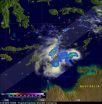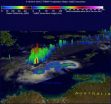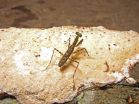(Press-News.org) NASA's TRMM satellite passed over the remnants of Tropical Cyclone Gillian and spotted some towering thunderstorms and areas of heavy rainfall, indicating there's still power in the former tropical storm.
Over the past few days former tropical cyclone Gillian's remnants moved from the Gulf of Carpentaria into the Timor Sea. The Tropical Rainfall Measuring Mission satellite known as TRMM found a few strong convective thunderstorms when it passed above these remnants on March 18, 2014 at 0431 UTC. TRMM's Precipitation Radar (PR) instrument measured rain falling at a rate of over 86 mm/3.4 inches per hour in some intense storms.
The Joint Typhoon Warning Center or JWTC recently assigned Gillian's remnants a medium chance to regain tropical cyclone status. Asimulated 3-D image was made at NASA's Goddard Space Flight Center in Greenbelt, Md. using TRMM PR data. The 3-D image showed that several of the tallest thunderstorms in Gillian's remnants were reaching heights of over 15.75 km/9.8 miles. Radar reflectivity values of over 50.7 dBZ were being returned to TRMM from the heavy rainfall within these storms.
The Australian Bureau of Meteorology issued their last statement on Gillian's remnants on March 18 at 10:45 p.m. CST local time/Darwin. At that time, Ex-Tropical Cyclone Gillian was located 9.6 south latitude and 128.4 east longitude, about 330 km/205.1 miles east southeast of Dili and 525 km/326.2 miles east of Kupang and moving west at 24 kph/38.6 mph.
Gillian's remnants, now in the Southern Indian Ocean basin, are expected to continue moving to the west across the Timor Sea, away from the Northern Territory.
INFORMATION:Text credit: Hal Pierce
NASA's Goddard Space Flight Center
NASA sees some strength left in remnants of Tropical Cyclone Gillian
2014-03-18
ELSE PRESS RELEASES FROM THIS DATE:
Incentives needed to improve grain markets in India
2014-03-18
URBANA, Ill. – Even after the agricultural reforms of 2002-03, for wheat, rice, and pearl millet farmers in India, grain markets are still pretty sticky. Two University of Illinois economists analyzed infrastructure of interstate trade for food-grain crops in three Indian states and found that grain farmers are unable to cash in on India's market reforms and take advantage of a price difference between two or more markets.
"We wanted to see if there was more integration in the markets since the 2002 reforms," said Kathy Baylis. "We were surprised at how little integration ...
MU study uses video-game device with goal of preventing patient falls
2014-03-18
Technology used in video games is making its way to hospital rooms, where researchers at the University of Missouri hope to learn new ways to prevent falls among hospital patients.
Between 700,000 and 1 million people each year fall in U.S. hospitals, according to the Agency for Healthcare Research and Quality. Hospitals nationwide are looking for ways to reduce that number.
"Since 2008, we've investigated ways to detect and prevent falls by older adults living in independent senior apartments," said Marilyn Rantz, PhD, RN, a leader of the MU research team and a professor ...
Reintroduction experiments give new hope for a plant on the brink of extinction
2014-03-18
A critically endangered plant known as marsh sandwort (Arenaria paludicola) is inching back from the brink of extinction thanks to the efforts of a UC Santa Cruz plant ecologist and her team of undergraduate students.
Ingrid Parker, the Langenheim professor of plant ecology and evolution at UC Santa Cruz, got involved in the marsh sandwort recovery effort at the request of the U.S. Fish and Wildlife Service (USFWS). Although it used to occur all along the west coast, from San Diego to Washington state, this wetland plant with delicate white flowers had dwindled to one ...
New therapeutic target discovered for Alzheimer's disease
2014-03-18
A team of scientists from the University of California, San Diego School of Medicine, the Medical University of South Carolina and San Diego-based American Life Science Pharmaceuticals, Inc., report that cathepsin B gene knockout or its reduction by an enzyme inhibitor blocks creation of key neurotoxic pGlu-Aβ peptides linked to Alzheimer's disease (AD). Moreover, the candidate inhibitor drug has been shown to be safe in humans.
The findings, based on AD mouse models and published online in the Journal of Alzheimer's Disease, support continued development of cysteine ...
Chronic sleep disturbance could trigger onset of Alzheimer's
2014-03-18
People who experience chronic sleep disturbance—either through their work, insomnia or other reasons—could face an earlier onset of dementia and Alzheimer's, according to a new pre-clinical study by researchers at Temple University.
"The big biological question that we tried to address in this study is whether sleep disturbance is a risk factor to develop Alzheimer's or is it something that manifests with the disease," said Domenico Praticò, professor of pharmacology and microbiology/immunology in Temple's School of Medicine, who led the study.
Initially, the researchers ...
Parents matter more than they think in how their children eat
2014-03-18
AURORA, Colo. (March 17, 2014) - Helping children learn to eat well can be a challenge. Some children happily eat whatever is put in front of them while others seem to eat like birds and exist more on air than food. A new study by a researcher at the University of Colorado School of Medicine shows that parents influence how much children eat more than they may think.
In this collaborative study between the CU School of Medicine, Baylor College of Medicine and University of Alabama Birmingham, researchers observed normal, everyday mealtimes in the homes of 145 parents ...
An end to animal testing for drug discovery?
2014-03-18
DALLAS, March 18, 2014 — As some countries and companies roll out new rules to limit animal testing in pharmaceutical products designed for people, scientists are stepping in with a new way to test therapeutic drug candidates and determine drug safety and drug interactions — without using animals. The development of "chemosynthetic livers," which could dramatically alter how drugs are made, was presented at the 247th National Meeting & Exposition of the American Chemical Society (ACS), the world's largest scientific society.
The meeting features more than 10,000 presentations ...
Form of epilepsy in sea lions similar to that in humans, Stanford researchers find
2014-03-18
STANFORD, Calif. — California sea lions exposed to a toxin in algae develop a form of epilepsy that is similar to one in humans, according to a new study led by Stanford University School of Medicine researchers.
Every year, hundreds of sea lions wash up along the California coast, suffering seizures caused by exposure to domoic acid, a neurotoxin that can produce memory loss, tremors, convulsions and death. Domoic acid is produced by algae blooms that have been proliferating along the coast in recent years, accumulating in anchovies and other small fish that the sea ...
New view of supernova death throes
2014-03-18
WASHINGTON D.C., March 18, 2014 -- A powerful, new three-dimensional model provides fresh insight into the turbulent death throes of supernovas, whose final explosions outshine entire galaxies and populate the universe with elements that make life on Earth possible.
The model is the first to represent the start of a supernova collapse in three dimensions, said its developer, W. David Arnett, Regents Professor of Astrophysics at the University of Arizona, who developed the model with Casey Meakin and Nathan Smith at Arizona and Maxime Viallet of the Max-Planck Institut ...
Nineteen new speedy praying mantis species discovered that hide and play dead to avoid capture
2014-03-18
A scientist has discovered 19 new species of praying mantis from Central and South America. The new species of bark mantises were discovered in tropical forests and also found among existing museum collections. Dr. Gavin Svenson, curator of invertebrate zoology at The Cleveland Museum of Natural History, described the new species and published a revision of the genus Liturgusa in the open access journal ZooKeys.
Svenson collected the insects from eight countries in Central and South America, as well as gathered hundreds of specimens from 25 international museums in ...




